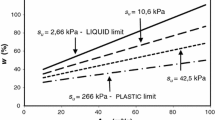Abstract
Surveys were performed to prove the probability of using the scaling techniques in modeling the key hydro-mechanical characteristics based on the granulometric structure of soils and the subsequent optimization processes for amelioration. The spatial soil heterogeneity significantly complicates modeling the moisture transfer, which depends on the hydrophysical moisture-transport properties in media. In order to describe the spatial heterogeneity, scaling techniques are most effective. The scaling technique is used in the survey to estimate the average (base) curve of the key hydrophysical characteristics with the data on the soil granulometric structure. The model for the moisture transport in an unsaturated zone of aeration was built based on the K. Kosugi target-regression model allowing us to reduce the number of hydrophysical parameters based on the soil granulometric structure. In order to describe the soil heterogeneity, the physical scaling technique was used based on the lognormal particle-size distribution in soils. Therefore, the parameters for the key hydrophysical characteristics were defined as mean values and the dispersions of lognormal soil-particle-size distribution were determined. The survey objects were the soil samples of different types of granulometric structure, such as sand, loamy sand, sandy loam, and loam, and their granulometric structure. Unlike common scaling, physical scaling can provide the theoretically proper interpretation of scaling coefficients, assuming a lognormal distribution of radii uniquely related to the soil pressure. Certain specimens at random sampling have a base curve typical for hydrophysical aggregate properties. The key hydrophysical aggregate characteristics expressed as a base curve binding the samples by the scaling coefficients can adequately reflect the hydrophysical properties of a soil horizon. Similar scaling allows us to physically prove the parameters for the key hydrophysical characteristics, providing hydrophysical parameterization in a study area. This fact is rather important in the practical aspect, especially in the problem-solving tasks related to amelioration, the studies focused on the water-balance dynamics, and the integrated water-resources management.




Similar content being viewed by others
REFERENCES
Mazirov, M.A. and Shein, E.V., Polevye issledovaniya svoistv pochv (Field Studies of Soil Properties), Vladimir: Vladimir. Gos. Univ., 2012.
Ryzhova, T.A., Melikhova, E.V., and Rogachev, A.F., Computer modeling and determination of the basis of hydrophysical characteristic on the example of light - chestness soils of the Lower Volga region, Izv. Nizhne-volzh. Agrouniv. Kompleksa: Nauka Vyssh. Prof. Obraz., 2019, vol. 55, no. 3, pp. 397–406.
Salugin, A.N., Kulik, A.K., and Vlasenko, M.V., Water permeability of unsaturated soils in the arid zone, Ross. S-kh. Nauka, 2017, no. 1, pp. 21−24.
Sudnitsyn, I.I., Effect of the size of elementary soil particles on the soil moisture characteristic curve, Eurasian Soil Sci., 2015, vol. 48, pp. 735–741.
Salugin, A.N., Application of main hydrophysical characteristics for modeling of vertical moisture motion in the aeration area, Izv. Nizhnevolzh. Agrouniv. Kompleksa: Nauka Vyssh. Prof. Obraz., 2018, vol. 49, no. 2, pp. 58−65.
Terleev, V.V., Dunaeva, E.A., Ginevskii, R.S., et al., Soil-hydrophysical information support of precise irrigation farming, Tavricheskii Vestn. Agrar. Nauki, 2021, no. 2, vol. 26, pp. 244–260.
Terleev, V.V., Narbut, M.A., Topazh, A.G., et al., Modeling of hydrophysical properties of the soil as capillary-porous media and improvement of Mualem-Van Genuchten method: Theory, Agrofizika, 2014, vol. 14, no. 2, pp. 35−44.
Umarova, A.B., Shein, E.V., and Kukharuk, N.S., The main hydrophysical characteristic of agrosphere soils: the influence of anisotropy and the scaling factor, Pochvovedenie, 2014, no. 12, pp. 1460–1466.
Chelovechkova, A.V., Use of software modeling for construction and analysis of the basic hydrophysical characteristics of leached chernozems of the Trans-Urals, Al’m. Mirovoi Nauki, 2016, vol. 8, nos. 1–5, pp. 48–49.
Kosugi, K., Lognormal distribution model for unsaturated soil hydraulic properties, Water Resour. Res., 1996, vol. 32, pp. 2697−2703.
Kosugi, K. and Hopmans, J.W., Scaling water retention curves for soils with lognormal pore-size distribution, Soil Sci. Soc. Am. J., 1998, vol. 62, no. 6, pp. 1496−1505.
Gardner, W.R., Representation of soil aggregate-size distribution by a logarithmic-normal distribution, Soil Sci. Soc. Am. J., 1956, vol. 20, no. 2, pp. 151−153.
Shaokun’, Ma., Syao, Kh., Chzhibo, D., Min’, Ma., Yui, Sh., Model for predicting the main hydrophysical characteristics of the swelling soil, considering drying and wetting cycles, Fiz.-Tekh. Probl. Razrab. Polezn. Iskop., 2021, no. 3, pp. 38–50.
Bezerra-Coelho, C.R., Zhuang, L., Barbosa, M.C., et al., Further tests of the HYPROP evaporation method for estimating the unsaturated soil hydraulic properties, J. Hydrol. Hydromech., 2018, vol. 66, no. 2, pp. 161–169. https://doi.org/10.1515/johh-2017-0046
Umarova, A.B., Shein, E.V., and Kukharuk, N.S., The main hydrophysical characteristic of agrogray soils: influence of anisotropy and the scaling factor, Pochvovedenie, 2014, no. 12, pp. 1460–1466.
Liang, J., Li, W., Bradford, S.A., et al., Physics-informed data-driven models to predict surface runoff water quantity and quality in agricultural fields, Water, 2019, vol. 11, no. 2, art. ID 200. https://www.researchgate.net/publication/304755334_doi103390ijms17060953. Cited February 15, 2022. https://doi.org/10.3390/w11020200
Medvedev, S.A., Poluektov, R.A., and Topazh, A.G., Irrigation strategy optimization using methods of polyvariant analysis of agroecosystem dynamics, Melior. Vodn. Khoz., 2012, no. 2, pp. 10–13.
Rahmati, M., Vanderborght, J., and Šimůnek, J., Soil hydraulic properties estimation fromone-dimensional infiltration experiments using characteristic time concept, Vadose Zone J., 2020, pp. 1–22. https://acsess.onlinelibrary.wiley.com/share/FQTIJKMVNWSZQQ6WEWGE?target=10.1002/vzj2.20068. Cited February 15, 2022.
Nasta, P., Romano, N., Assouline, S., et al., Prediction of spatially variable unsaturated hydraulic conductivity using scaled particle-size distribution functions, Water Resour. Res., 2013, vol. 49, no. 7, pp. 4219–4229.
Alekseev, V.V. and Maksimov, I.I., Aerodynamic method for obtaining the main hydrophysical characteristics of soils, Pochvovedenie, 2013, no. 7, pp. 822–828.
Funding
The survey was performed within State Task no. FNFE-2022-0011.
Author information
Authors and Affiliations
Corresponding authors
Ethics declarations
Conflict of interest. The authors declare that they have no conflicts of interest.
Additional information
Translated by O. Zhiryakova
About this article
Cite this article
Salugin, A.N., Melikhova, E.V. & Ryzhova, T.A. Scaling Hydrophysical Characteristics of Soils. Russ. Agricult. Sci. 48, 128–133 (2022). https://doi.org/10.3103/S1068367422030120
Received:
Revised:
Accepted:
Published:
Issue Date:
DOI: https://doi.org/10.3103/S1068367422030120




